The Fastest 3D Cards Go Head-To-Head
GeForce GTX 260 OC
The GeForce GTX 260 is fitted with 896 MB of GDDR3 memory (on a 448-bit bus) and supports DirectX 10. The default clock rates are 576 MHz for the GPU, 1,242 MHz for the shaders, and 1,998 MHz for the memory. On our sample, MSI overclocked those frequencies to 620, 1,296 and 2,160 MHz, respectively. The best gain is seen in Mass Effect (UT3 Engine) at 1920x1200 pixels with anti-aliasing enabled—the overclocked values yield a frame rate increase of 14.2%. If you take the average of all the games included in the benchmark suite, the gain is 4.5%, which halves the gap between GeForce GTX 260 and a normally-clocked GTX 280.
In 3D performance, the GTX 260 puts up a tough fight against AMD’s Radeon HD 4870. At 1280x1024, the GTX 260 is actually better, while at 1680x1050 pixels (without anti-aliasing) the HD 4870 wins by 1.4%. With anti-aliasing enabled, the GTX 260 is 10% faster. At 1920x1200 without AA, the HD 4870 wins by a couple of frames per second, but with anti-aliasing turned on, the GTX 260 is 6% faster. Here the fast GDDR5 memory on the Radeon card starts to make itself felt. The considerable drop in price to $290, makes the GTX 260 a good alternative to the slightly weaker and now comparably-priced AMD Radeon HD 4870.
Unusually, the noise the GTX 260 generates while sitting on the Windows desktop is reasonable, in the neighborhood of 38.1 dB(A). After testing in 3D mode, the fan couldn’t make up its mind. The temperature dropped to 45 degrees C, but the speed didn’t change. The card was running without load, but we could still hear up to 44.2 dB(A). The speed re-adjustment only occurred in the test with the X38-based motherboard. It did not manifest itself on the 780i-based board.
The power consumption of the GTX 260 in 2D mode is considerably lower than either of AMD’s offerings. As soon as the GTX 260 comes out of 3D mode, it switches to its low-power 3D profile (GPU at 400 MHz, shaders at 800 MHz, and memory at 600 MHz), where it draws 125 watts of power for the entire system. After a few more seconds of idle, the clock rate is switched into 2D mode (GPU at 300 MHz, shaders at 600 MHz, and memory at 200 MHz). Overall consumption falls to 111 watts. Under 3D full load, the GeForce GTX 260 consumes 336 watts. A solid power supply with 280 to 320 watts of overall power and 23 to 27 A on the 12 volt rail should be sufficient here.










Get Tom's Hardware's best news and in-depth reviews, straight to your inbox.
Current page: GeForce GTX 260 OC
Prev Page CrossFire With Radeon HD 4870 OC Next Page SLI With GeForce GTX 260 OC-
San Pedro Looks like the results for SLI and Crossfire were switched with the single card results. . .Reply -
Duncan NZ Not a bad article, really comprehensive.Reply
My one complaint? Why use that CPU when you know that the test cards are going to max it out? Why not a quad core OC'ed to 4GHz? It'd give far more meaning to the SLI results. We don't want results that we can duplicate at home, we want results that show what these cards can do. Its a GPU card comparason, not a complain about not having a powerful enough CPU story.
Oh? And please get a native english speaker to give it the once over for spelling and grammar errors, although this one had far less then many articles posted lately. -
Lightnix It'd be a good article if you'd used a powerful enough CPU and up to date Radeon drivers (considering we're now up to 8.8 now), I mean are those even the 'hotfix' 8.6's or just the vanilla drivers?Reply -
elbert Version AMD Catalyst 8.6? Why not just say i'm using ATI drivers with little to no optimizations for the 4800's. This is why the CF benchmarks tanked.Reply -
at 1280, all of the highend cards were CPU limited. at that resolution, you need a 3.2-3.4 c2d to feed a 3870... this article had so much potential, and yet... so much work, so much testing, fast for nothing, because most of the results are very cpu limited (except 1920@AA).Reply
-
wahdangun WTF, hd4850 SHOULD be a lot faster than 9600 GT and 8800 GT even tough they have 1Gig of ramReply -
mjam No 4870X2 and 1920 X 1200 max resolution tested. How about finishing the good start of an article with the rest of it...Reply -
I agree, the 4870 X2 should have been in there and should have used the updated drivers. Good article but I think you fell short on finishing it.Reply
-
@pulasky - Rage much? It's called driver issues you dumbass. Some games are more optimised for multicard setups than others, and even then some favour SLi to Crossfire. And if you actually READ the article rather than let your shrinken libido get the better of you, you'll find that Crossfire does indeed work in CoD4.Reply
Remember, the more you know.
